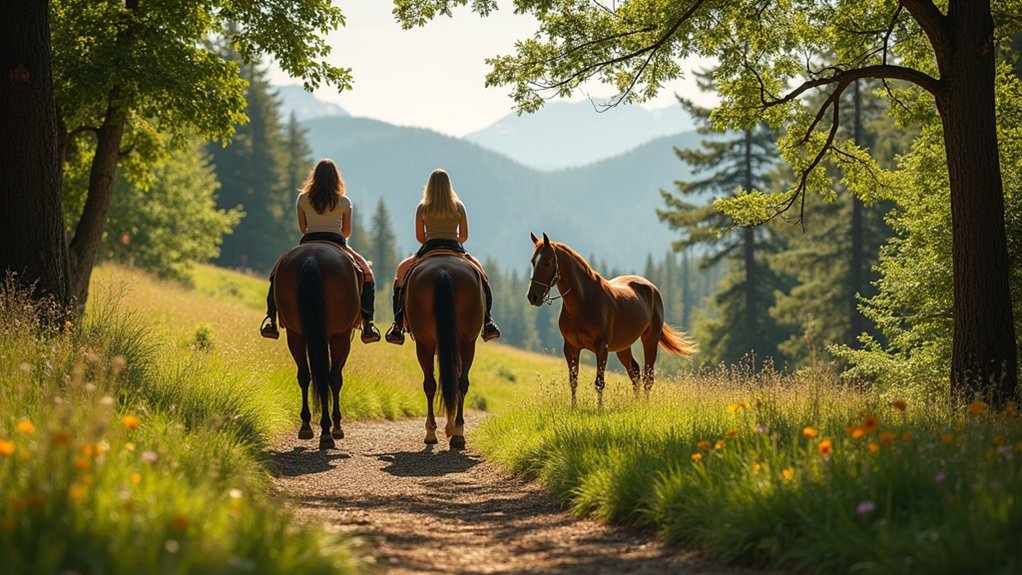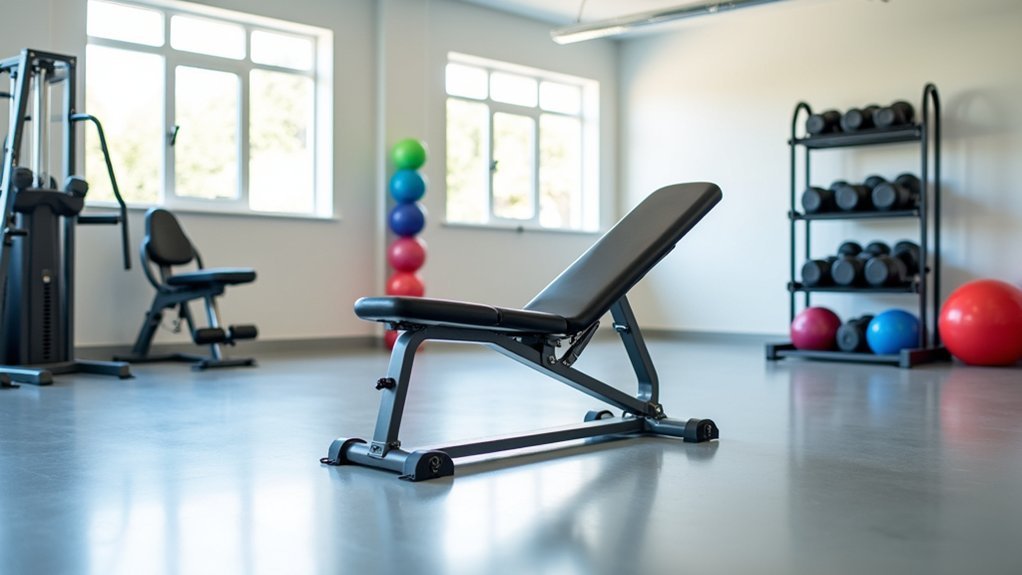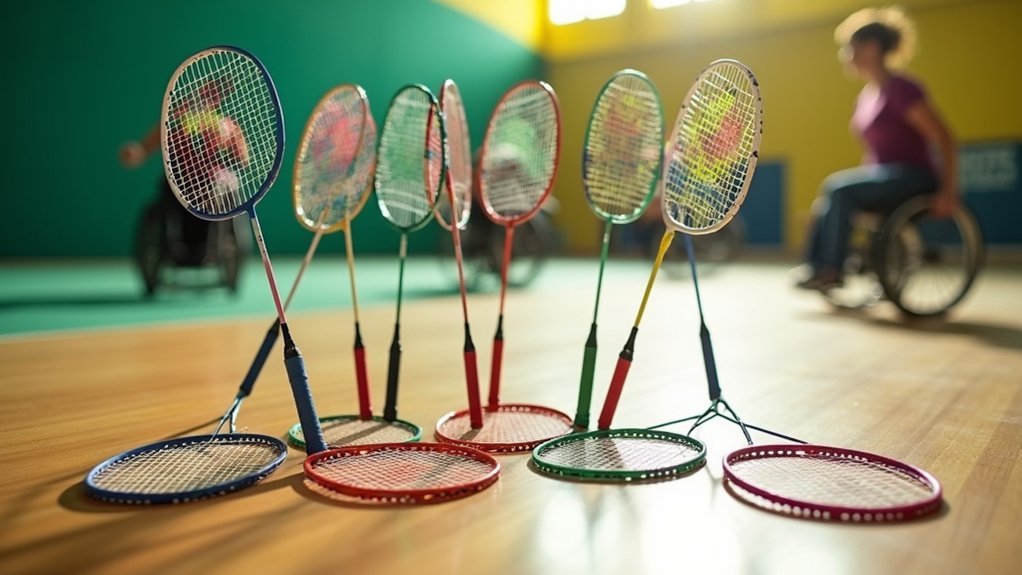Horseback riding on forest trails creates a multi-sensory healing experience for your body and mind. The horse’s rhythmic movement mimics your natural walking gait, engaging core muscles while releasing stress-reducing endorphins and neurotransmitters. Simultaneously, forest surroundings enhance mindfulness and mental clarity as you form a powerful emotional bond with your equine partner. This unique combination strengthens your physical body while calming your nervous system. Discover how this ancient partnership continues to transform modern wellness approaches.
The Therapeutic Rhythm of Horseback Movement

A remarkable phenomenon occurs when you settle into a horse’s saddle and begin to move together. The gentle, rhythmic motion mimics your natural walking gait, instantly creating a meditative effect that melts away stress. This synchronization isn’t just soothing—it’s transformative.
As you ride, your core muscles engage while your body learns to balance with each stride. Your proprioception improves as you adapt to the horse’s movements, enhancing your body awareness and emotional regulation abilities.
The dance between rider and horse silently strengthens your body while teaching your mind the language of balance.
The therapeutic benefits of horseback riding extend beyond physical fitness. Each step triggers the release of endorphins, oxytocin, serotonin, and dopamine—nature’s antidepressants.
This neurochemical cocktail explains why riders often report significant reductions in anxiety and depression symptoms, confirming what equestrians have intuitively known for centuries.
Nature’s Healing Symphony: Forest Trails and Mental Health
Forest trails offer a powerful companion to horseback riding’s therapeutic benefits, creating what scientists call a “green mind” effect.
When you ride horses through wooded paths, you’re engaging in a powerful form of mindfulness that greatly reduces stress and enhances emotional well-being.
The combination is particularly potent—your body absorbs the rhythmic motion of your horse, triggering releases of serotonin and dopamine that create genuine happiness.
Meanwhile, your senses drink in the forest’s natural symphony. You’ll notice improved focus and mental clarity as the sensory richness of nature complements your equine connection.
For those facing mental health challenges, this dual therapy offers remarkable cognitive stimulation.
The forest’s soothing atmosphere amplifies horseback riding’s therapeutic effects, creating moments of peace and emotional renewal that linger long after your ride ends.
Building Strength Through Adaptive Riding Techniques

Transformation occurs naturally when bodies meet horses on adaptive trails.
You’ll discover your core, leg, and back muscles engaging in ways traditional exercise can’t replicate. Adaptive riding techniques aren’t just about staying mounted—they’re strategic health interventions that build physical power through intentional body positioning and balance exercises.
Whether you’re recovering from injury or managing a disability, these tailored riding programs develop targeted muscle groups while respecting your unique needs.
The consistent physical exertion strengthens muscles that may otherwise remain unchallenged in daily life.
Beyond the measurable gains in physical strength, you’ll notice something equally valuable emerging: confidence.
As your body grows stronger through adaptive riding, independence follows—creating a powerful cycle of improved health that extends far beyond the saddle.
The Horse-Human Bond: Creating Trust and Connection
You’ll notice how horses instantly mirror your emotional state, creating a profound silent conversation that transcends words.
This intuitive connection allows you to communicate through body language and energy, establishing a relationship built on mutual understanding.
When you’re anxious, your equine partner senses it; when you’re calm and confident, your horse responds in kind, teaching you the power of authentic emotional presence.
Mirroring Emotional States
The remarkable intuition of horses creates a powerful emotional feedback loop between animal and rider. When you approach your horse anxious or stressed, they’ll reflect those emotions back to you—offering a rare opportunity for emotional regulation and self-awareness.
This mirroring effect becomes a silent conversation that strengthens your bond through trust and mutual understanding.
The horse-human connection deepens through:
- Physical synchronization – Your heartbeats can align during rides, creating a calming rhythm that soothes both your nervous systems.
- Nonverbal communication – You’ll learn to express intentions through body language, enhancing your emotional intelligence.
- Honest feedback – Horses provide unfiltered responses to your emotional state, encouraging authentic self-expression and awareness.
Silent Language Connection
Beyond spoken words lies the profound silent language between horses and humans—a communication system built on intuition, body cues, and emotional awareness. You’ll discover that horses read your energy before you’ve consciously expressed it, making them exceptional partners in therapy.
| Body Language Signal | Horse Response | Human Benefit |
|---|---|---|
| Relaxed posture | Lowered head | Reduced anxiety |
| Controlled breathing | Synchronized breathing | Emotional regulation |
| Confident movement | Willing following | Improved self-esteem |
| Open, calm energy | Relaxed muscles | Stress reduction |
As you develop this silent connection, you’re learning a universal language that transcends words. Your body language becomes clearer, your emotional awareness sharper. This non-verbal dialogue creates a feedback loop where the horse’s responses help you recognize your own emotional states—forming the foundation of equine therapy’s effectiveness.
Accessible Trail Design for All Abilities

When designing trails that truly serve everyone, accessibility becomes the cornerstone of creating healing outdoor experiences.
You’ll find that accessible trails thoughtfully integrate features like crushed stone surfaces and gentle slopes, making interacting with horses possible for riders of all abilities. These intentional designs remove barriers and open nature’s therapeutic benefits to everyone.
- Supportive infrastructure – Rest areas, ramps, and handrails provide essential support points for riders who need assistance or breaks.
- Navigational clarity – Clear signage and markers help all users, especially those with visual or cognitive challenges, move confidently through trails.
- Community creation – Inclusive design fosters connections among diverse riders, building a supportive environment where everyone experiences the healing power of horses together.
Sensory Benefits of Outdoor Equine Experiences
Stepping from well-designed trails into the sensory world of outdoor equine experiences opens a doorway to profound healing.
You’ll immediately notice the calming effect as multiple senses engage simultaneously—the rhythmic sound of hooves on varied terrain lowers your stress levels while creating a meditative atmosphere.
The natural light you’re exposed to during these sessions regulates your mood and boosts vitamin D levels, enhancing your mental health.
As you ride, you’ll feel the wind against your skin and experience the horse’s movements, improving your coordination and deepening your connection with your equine partner.
These sensory benefits transport you away from daily stressors into a state of mindfulness.
The sights, sounds, and smells of nature combine with equine interaction to create a therapeutic environment where healing naturally occurs.
Equine-Assisted Therapy for Emotional Regulation
Horses serve as intuitive mirrors for human emotions, making equine-assisted therapy particularly effective for emotional regulation. When you interact with these sensitive animals, they respond directly to your body language and energy, helping you recognize and manage emotions you mightn’t even realize you’re expressing.
This natural feedback mechanism creates powerful opportunities for emotional growth and anxiety reduction.
The therapeutic benefits extend beyond simple interaction:
- The release of oxytocin and serotonin during horse interactions creates neurological pathways promoting feelings of safety and well-being.
- Rhythmic riding movements naturally calm your nervous system, allowing for improved emotional processing.
- Structured equine activities develop essential communication skills that transfer to everyday emotional challenges.
Through consistent participation, you’ll likely experience significant improvements in emotional stability and develop effective strategies for managing anxiety.
From Saddle to Self-Confidence: Psychological Transformations
When you’re perched atop a thousand-pound animal, conquering your fears through deliberate action creates immediate psychological rewards.
Your growing bond with the horse mirrors improvements in your confidence with people, as the animal responds honestly to your leadership and emotional state.
The natural rhythm of horseback riding calms your nervous system, creating a meditative space where you’ll discover strengths you never knew existed.
Overcoming Fear Through Action
Facing the towering presence of a 1,200-pound horse can trigger instinctive fear in even the most confident individuals. Yet this is precisely what makes working with horses so transformative. When you choose action over avoidance, you’re rewiring your brain to process fear differently.
Each time you mount up despite your anxiety, you’re building neural pathways that strengthen your emotional resilience.
Working with horses teaches you to:
- Recognize fear as information rather than a command to retreat
- Trust your ability to communicate with a powerful animal through subtle cues
- Value progress over perfection as you develop riding skills incrementally
Your horse becomes a mirror, reflecting your emotional state while offering immediate feedback.
This unique partnership doesn’t eliminate fear—it teaches you to function effectively alongside it, a skill that extends far beyond the riding arena.
Building Trust With Animals
The journey toward building trust with a horse begins not with words, but with energy and intention. When you approach these sensitive creatures, they immediately read your emotional state, responding to your anxiety or confidence with matching behavior.
As you learn to control your emotions around horses, you’ll feel a profound shift in self-awareness. During grooming sessions and rides, you’re building a silent language of mutual respect. The horse’s response to your cues becomes a mirror, reflecting your internal state.
This trust-building process extends beyond the stable. You’ll notice yourself handling human relationships with new confidence, carrying the lessons from equine connections into everyday interactions.
The skills you develop—reading non-verbal cues, managing your energy, and establishing boundaries—become tools for maneuvering through life’s challenges with greater emotional intelligence.
Nature’s Therapeutic Rhythm
Rhythmic hoofbeats create a natural cadence that synchronizes with your heartbeat as you ride along wooded trails. This rhythmic motion isn’t just pleasant—it’s medicinal. Your body releases oxytocin and serotonin with each stride, melting away stress and anxiety while creating a meditative state that’s particularly beneficial for managing various health issues.
The therapeutic power of this natural rhythm works on multiple levels:
- Physical healing – The motion strengthens your core muscles while improving coordination and balance.
- Mental clarity – The cadence promotes mindfulness, allowing you to disconnect from daily worries.
- Emotional release – Each step helps you process emotions through movement rather than overthinking.
You’ll find yourself returning from rides not just physically exercised, but mentally refreshed and emotionally balanced.
Adaptive Equipment Innovations for Inclusive Riding
While traditional horseback riding presents significant barriers for many individuals with disabilities, modern adaptive equipment has revolutionized access to equestrian experiences.
You’ll find specialized saddles with enhanced support, non-slip stirrups, and custom harnesses that guarantee both comfort and safety during your ride.
Spending time with horses becomes more accessible through innovative mounting systems, including ramps and transfer benches that enable independent access to horseback.
If you have limited hand function, you’ll benefit from specialized reins with textured grips that improve control and confidence.
Protection hasn’t been overlooked either, with therapeutic helmets featuring additional padding and adjustable elements.
The industry continues to evolve, incorporating virtual reality simulations and remote coaching technology that makes equestrian therapy available to riders with diverse needs.
The Science Behind Horses as Natural Stress Relievers
Horses offer more than just physical support through adaptive equipment—they provide profound neurobiological benefits backed by scientific research. When you interact with horses, your brain releases oxytocin, serotonin, and dopamine while reducing cortisol levels, creating a natural antidote to issues such as anxiety and depression.
The therapeutic value of equine interaction works through:
- Sensory regulation – The rhythmic sound of hooves and riding motion creates a meditative state that improves mental clarity.
- Biochemical response – Your body’s stress hormones decrease during horse interactions, promoting relaxation and emotional stability.
- Physical engagement – Moving with and around horses encourages activity that naturally elevates mood and reduces anxiety symptoms.
This science explains why even brief time spent with horses leaves you feeling noticeably calmer and more centered.
Trail Riding for Mobility Enhancement and Recovery
Beyond its calming effects, trail riding offers remarkable physical benefits that transform rehabilitation and recovery efforts.
When you’re seated on horseback traversing varied terrain, you’re engaging core, leg, and back muscles with every step your mount takes. This rhythmic movement has a transformative impact on your physical abilities, improving strength and coordination naturally.
You’ll discover that the low-impact nature of riding makes it ideal for recovery from injuries or mobility challenges.
As you balance atop your horse on different trails, you’re developing stability skills essential for rehabilitation. The cardiovascular benefits come without the harsh impact of traditional exercises, while the sense of adventure keeps you motivated to continue your physical journey.
Trail riding turns therapy into an experience you’ll actually look forward to.
Community and Connection: The Social Benefits of Group Trail Rides
When several riders gather on wooded paths, they create more than just a string of horses on a trail—they forge meaningful human connections that enhance healing.
You’ll find your social well-being improved as you navigate trails together, sharing experiences that combat isolation and build lasting friendships.
These communal riding experiences offer valuable emotional support, creating a network of fellow enthusiasts who understand your challenges and celebrate your successes.
Your mental health benefits from the positive shared experiences and regular interaction.
- Group rides transform solitary activities into community events, fostering belonging
- Communication skills develop naturally as you coordinate movements and share observations
- Supportive relationships form, creating a safety net for difficult times in your life
Frequently Asked Questions
How Horses Are Healing Powers on Mental Health?
Horses heal your mental health by releasing neurotransmitters like oxytocin when you interact with them. They’ll provide a judgment-free space for emotional exploration, reduce anxiety through rhythmic riding, and boost your confidence as you develop new skills.
What Is the Spiritual Connection to Horses?
You’ll find horses mirror your emotions, creating a profound spiritual bond. They sense your energy, offering a pathway to self-discovery. When riding, you’ll experience unity with nature and moments of transcendent peace.
Why Do Horses Heal Humans?
Horses heal you through natural biochemistry—releasing oxytocin, serotonin, and dopamine when you interact. They’re intuitive companions who sense your emotions, lower your cortisol levels, and improve your self-esteem through their non-judgmental presence and rhythmic movements.
How Does Horse Riding Help With Mental Health?
When you ride horses, you’ll experience a surge of feel-good chemicals like oxytocin and dopamine. The rhythmic movement calms your mind, while building confidence and emotional regulation skills through your unique horse-human connection.
In Summary
You’ve discovered the remarkable connection between horses, trails, and healing. As you continue your journey, you’ll find that this powerful combination doesn’t just strengthen your body—it renews your mind and spirit. Whether you’re seeking physical rehabilitation, emotional balance, or simply a deeper connection to nature, remember that the rhythmic hoofbeats and winding paths offer a timeless therapy that’s accessible to everyone willing to saddle up.





Leave a Reply